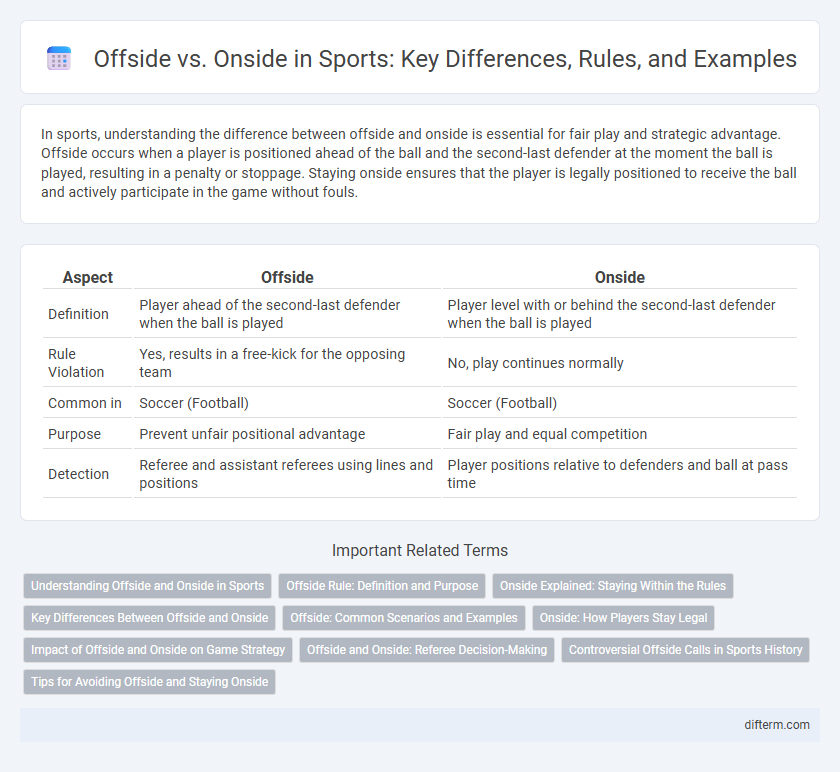In sports, understanding the difference between offside and onside is essential for fair play and strategic advantage. Offside occurs when a player is positioned ahead of the ball and the second-last defender at the moment the ball is played, resulting in a penalty or stoppage. Staying onside ensures that the player is legally positioned to receive the ball and actively participate in the game without fouls.
Table of Comparison
| Aspect | Offside | Onside |
|---|---|---|
| Definition | Player ahead of the second-last defender when the ball is played | Player level with or behind the second-last defender when the ball is played |
| Rule Violation | Yes, results in a free-kick for the opposing team | No, play continues normally |
| Common in | Soccer (Football) | Soccer (Football) |
| Purpose | Prevent unfair positional advantage | Fair play and equal competition |
| Detection | Referee and assistant referees using lines and positions | Player positions relative to defenders and ball at pass time |
Understanding Offside and Onside in Sports
Offside and onside rules are crucial in sports like soccer and rugby to ensure fair play and maintain game flow. An offside position occurs when a player is nearer to the opponent's goal line than both the ball and the second-last defender at the moment the ball is played, leading to a stoppage and turnover. Onside players, positioned correctly behind the ball or level with the second-last defender, remain eligible to receive passes and participate actively in offensive plays.
Offside Rule: Definition and Purpose
The offside rule in sports like soccer is designed to prevent attacking players from gaining an unfair advantage by being closer to the opponent's goal than both the ball and the second-last defender at the moment the ball is played to them. This rule ensures fair play by promoting strategic positioning and teamwork while discouraging goal-hanging. Enforcing offside maintains the flow of the game and encourages skillful play during offensive maneuvers.
Onside Explained: Staying Within the Rules
Onside refers to a player's position being legally aligned with the ball and opponents at the moment the ball is played, ensuring active participation without breaking the rules. Staying onside requires maintaining one or more defenders between the player and the goal line, preventing unfair advantages during attacking plays. Understanding the onside rule is crucial for strategic positioning and avoiding penalties in sports like soccer and rugby.
Key Differences Between Offside and Onside
Offside occurs when an attacking player is positioned nearer to the opponent's goal line than both the ball and the second-last defender at the moment the ball is played to them, resulting in a rule violation and stoppage of play. Onside means the player is legally positioned in line with or behind the second-last defender and the ball, allowing continuous play without penalties. Understanding this distinction is crucial for interpreting referee decisions and tactical positioning in football (soccer).
Offside: Common Scenarios and Examples
Offside occurs when an attacking player is positioned nearer to the opponent's goal line than both the ball and the second-last defender at the moment the ball is played to them. Common scenarios include a striker receiving a through ball while standing beyond the defensive line or wingers making runs behind defenders during counterattacks. Understanding the offside rule helps referees and players avoid penalties and maintain fair play in football matches.
Onside: How Players Stay Legal
Players stay onside by ensuring at least part of their body is aligned with or behind the second-last defender when the ball is played to them. Proper positioning relies on constant awareness of defenders' locations and timing of runs to avoid being penalized for offside. Maintaining onside position enhances attack opportunities, allowing legal forward passes that comply with offside rules.
Impact of Offside and Onside on Game Strategy
Offside positions often disrupt attacking momentum, forcing teams to adapt by emphasizing precise timing and spatial awareness to maintain offensive pressure. Onside plays enable more fluid passing sequences and sustained attacks, allowing strategic exploitation of defensive gaps and fostering dynamic team coordination. Coaches implement tailored training to minimize offside infractions and maximize the strategic advantages of onside positioning, directly influencing game tempo and scoring opportunities.
Offside and Onside: Referee Decision-Making
Referee decision-making in offside and onside calls relies heavily on the precise moment the ball is played and the position of attacking players relative to the second-last defender. Advanced technologies such as VAR (Video Assistant Referee) and goal-line systems assist referees in accurately assessing offside infractions to ensure fair play. Consistent interpretation of the offside rule helps maintain game flow while preventing unfair advantages in soccer matches.
Controversial Offside Calls in Sports History
Controversial offside calls in sports history have often sparked intense debates and altered the outcomes of crucial matches, especially in football and ice hockey. Iconic moments like the 2010 FIFA World Cup goal by Frank Lampard, which was ruled offside despite clear ball crossing, highlight the complexities and limitations of referee decisions without video technology. The introduction of VAR and goal-line technology has since aimed to reduce such disputes, though offside calls remain one of the most challenging aspects for officials to judge accurately in real-time.
Tips for Avoiding Offside and Staying Onside
Maintaining an onside position requires constant awareness of both the ball and the second-last defender to time runs effectively and avoid offside calls. Players should use visual cues by scanning the defensive line before making forward runs and communicate closely with teammates to coordinate passes. Practicing timing drills and developing an intuitive sense of spatial positioning enhances the ability to stay onside during fast-paced game situations.
Offside vs Onside Infographic

 difterm.com
difterm.com